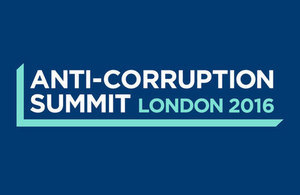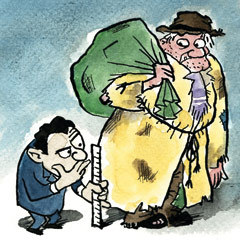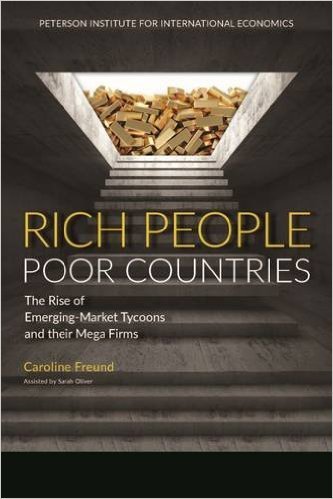Duncan Green's Blog, page 143
May 9, 2016
Should aid fight corruption? New book questions logic behind this week’s anti-corruption summit
Over at the Center for Global Development, Charles Kenny wants comments on the draft of his book on Aid and  Corruption (deadline end of May). Let’s hope this becomes standard practice – it worked brilliantly for me on How Change Happens – more varied voices can chip in good new ideas, spot mistakes or contradictions, and it all helps get a buzz going ahead of publication.
Corruption (deadline end of May). Let’s hope this becomes standard practice – it worked brilliantly for me on How Change Happens – more varied voices can chip in good new ideas, spot mistakes or contradictions, and it all helps get a buzz going ahead of publication.
But let me take it one step further. As a contribution to Thursday’s corruption summit, hosted by David Cameron, I thought I would summarize/review the book. Charles gave the green light, provided I stress the ‘preliminary, drafty, subject-to-revisiony nature of the text’. Done.
The summit is about a lot more than aid – for example the rich countries putting their houses in order on tax havens. Which is just as well, because the book poses some real challenges to the whole ‘anti-corruption’ narrative on aid. What’s more, it is erudite, engagingly written and upbeat – as you’d expect given Charles’ optimistic previous takes like Getting Better. He’s got a great eye for telling research and ‘man bites dog’ surprise findings. Example: ‘Taking a cross section of countries and comparing current income (2010) to corruption perceptions in 2002 and income in 2002, results suggests more corrupt countries in 2002 have higher incomes in 2010.’
His core argument is pretty striking – when it comes to aid and corruption, corruption does indeed matter, but the cure is often worse than the disease: ‘an important and justified focus on corruption as a barrier to development progress has led to policy and institutional change in donor agencies that is damaging the potential for aid to deliver development.’ Ouch.
 Not only that, but ‘there is a second ‘problem of corruption’ in development – and that is one of perception and response. A narrative that suggests weak governance is the major problem of development and an intractable one justifies aid fatigue (it’s broke, and we can’t fix it). Concern with weak governance and the risk of malfeasance is the primary justification for donor programs that involve heavy oversight or even direct selection, design and management of projects from distant donor capitals. Perhaps more importantly, countries perceived as corrupt also attract less foreign investment and trade.
Not only that, but ‘there is a second ‘problem of corruption’ in development – and that is one of perception and response. A narrative that suggests weak governance is the major problem of development and an intractable one justifies aid fatigue (it’s broke, and we can’t fix it). Concern with weak governance and the risk of malfeasance is the primary justification for donor programs that involve heavy oversight or even direct selection, design and management of projects from distant donor capitals. Perhaps more importantly, countries perceived as corrupt also attract less foreign investment and trade.
Were corruption an insurmountable stumbling block to delivering development and if we knew where was particularly corrupt, this second problem of corruption would not be a bug, it would be a feature. Tight control (if it worked) and aid fatigue (if it didn’t) would be a logical response. But the evidence that weak governance is a barrier to all development progress or effective aid programs just doesn’t stack up. And we know considerably less than is usually thought about which countries (or sectors, or activities) are weakly governed or particularly corrupt.’
Kenny argues that the focus on corruption feeds a generalized distrust of the state, but ‘distrust is a big problem because no country has become wealthy without a large government – one involved in a huge range of regulatory, investment and spending roles. By pandering to those who distrust government in the West, donors are helping to hobble governments in the developing world, with dire consequences for aid levels and effectiveness as well as broader development progress.’
And the double standards don’t end there, a focus on bribery (generally more prevalent in poor countries – see chart)

What wd this look like if it was tax evasion or spending on lobbying?
ignores the other kinds of corruption preferred in rich countries, from tax evasion to lobbying and political capture and ‘the general corrupting influence of money in the system’.
In the aid business, the obsessive focus on corruption has generated a ‘web of oversight and control institutions that ensure staff spend most of their time ensuring oversight requirements are met’. That means centralized approaches that ‘contradict the internationally agreed Paris Principles on aid effectiveness that aid which is ‘owned’ by recipient countries and runs through government budgets is likely to be more effective.’
Kenny’s suggestion for what to do?
‘It is time for a fundamental rethink of anti-corruption approaches in donor agencies. Rather than trying to measure the dimensions of the black box of corruption and change its internal dynamics, this book suggests shrinking the box through approaches that minimize the impact of corruption on aid delivering results. It also suggests using nonaid approaches to support systemic institutional reform.
There is a role for donor agencies in governance and anticorruption efforts, but, first, corruption is only one of many barriers to development, and, second, the role of outsiders in the process is limited, context specific and based on many unknowns.’

PbR theory of change
My main comment on reading the draft was that he dismisses too lightly the political economy arguments for donors obsessing about corruption (he just discounts them as ‘not convincing’). I think he needs to come up with a serious and plausible theory of change for how donors might change their ways. Just saying ‘build the evidence and they will come’ is a classic researcher’s cop-out that seldom works.
I was also a bit skeptical about the proposed solution, which is switching from corruption to payment by results. Is every CGD author now contractually obliged to say that, whatever the problem, the answer is PbR?………
Anyone else read it?

May 8, 2016
Links I Liked
The flood of bonkers/depressing stories from the US continued last week. The Economist spoke for many.
Plane flight delayed because alert passenger noticed Arabic-influenced mathematics (confusing Al-gebra with Al-Qaeda?)
PEPFAR wasted $1.4 billion telling people not to have sex. Way to go, guys.
 But it’s not all bad. Turns out Obama did a lot more than just reform healthcare. One of many positive first drafts of history.
But it’s not all bad. Turns out Obama did a lot more than just reform healthcare. One of many positive first drafts of history.
Now back to the rest of the world:
IMF warns of growing inequality in India and China, [h/t Nisha Agrawal]
A new Social Progress Index ranks countries against a 12 indicator mash up. Designed by economists, yet none of the indicators is about the economy. Go figure.
Responding to disasters is not just about getting people food, water and cash. The case for a global crisis education fund from the ODI.
Nice piece (despite random, misleading title) on rethinking how economics students are taught about/deal with data
And finally, the surprising (and decidedly unscientific) history of the word ‘Caucasian’. Intriguing 4m video [h/t Chris Blattman]
May 5, 2016
Here’s a summary of The Economist’s important critique of GDP and suggestions for reform
‘Laws are like sausages, it is better not to see them being made’ said Otto von Bismarck. Turns out you can probably  add GDP to that list.
add GDP to that list.
Last week’s Economist had a comprehensive takedown of the uses and abuses of Gross Domestic Product as an indicator of wellbeing, economic health or pretty much anything else. People have been critiquing GDP ever since it was created, but the Economist piece matters both because it shows that GDP is actually getting less useful over time, and also because it’s the Economist saying so. As a service to non subscribers, here’s a flavour of the critique from a 3 page briefing and some suggestions for reform from the accompanying leader.
First some of the more unpalatable ingredients of the GDP sausage:
‘In a world where houses are Airbnb hotels and private cars are Uber taxis, where a free software upgrade renews old computers, and Facebook and YouTube bring hours of daily entertainment to hundreds of millions at no price at all, many suspect GDP is becoming an ever more misleading measure.
The modern conception of GDP was a creature of the interwar slump and the second world war. A measure created when survival was at stake took little notice of things such as depreciation of assets, or pollution of the environment, let alone finer human accomplishments. In a famous speech in March 1968, Robert Kennedy took aim at what he saw as idolatrous respect for GDP, which measures advertising and jails but does not capture “the beauty of our poetry or the strength of our marriages”.
 A problem with GDP even when it is being asked to do nothing more than measure production is that it is a relic of a period dominated by manufacturing. In the 1950s, manufacturing made up more than a third of British GDP. Today it makes up a tenth. But the output of factories is still measured much more closely than that of services. Manufacturing output is broken down into 24 separate industries in the national accounts; services, which now make up 80% of the economy, are subdivided into only just over twice that number of categories.
A problem with GDP even when it is being asked to do nothing more than measure production is that it is a relic of a period dominated by manufacturing. In the 1950s, manufacturing made up more than a third of British GDP. Today it makes up a tenth. But the output of factories is still measured much more closely than that of services. Manufacturing output is broken down into 24 separate industries in the national accounts; services, which now make up 80% of the economy, are subdivided into only just over twice that number of categories.
A bias toward manufacturing is not the only distortion. By convention GDP measures only output that is bought and sold…. This convention means that so-called “home production”, such as housework or caring for an elderly relative, is excluded from GDP, even though such unpaid services have considerable value.’
So much for the critique, and here are the interesting suggestions for sorting it out:
‘Measuring prosperity better requires three changes. The easiest is to improve GDP as a gauge of production. Junking it altogether is no answer: GDP’s enduring appeal is that it offers, or seems to, a summary statistic that tells people how well an economy is doing. Instead, statisticians should improve how GDP data are collected and presented. To minimise revisions, they should rely more on tax records, internet searches and other troves of contemporaneous statistics, such as credit-card transactions, than on the standard surveys of businesses or consumers. Private firms are already showing the way—scraping vast quantities of prices from e-commerce sites to produce improved inflation data, for example.
Second, services-dominated rich countries should start to pioneer a new, broader annual measure, that would aim to  capture production and living standards more accurately. This new metric—call it GDP-plus—would begin with a long-overdue conceptual change: the inclusion in GDP of unpaid work in the home, such as caring for relatives. GDP-plus would also measure changes in the quality of services by, for instance, recognising increased longevity in estimates of health care’s output. It would also take greater account of the benefits of brand-new products and of increased choice. And, ideally, it would be sliced up to reflect the actual spending patterns of people at the top, middle and bottom of the earnings scale: poorer people tend to spend more on goods than on Harvard tuition fees.
capture production and living standards more accurately. This new metric—call it GDP-plus—would begin with a long-overdue conceptual change: the inclusion in GDP of unpaid work in the home, such as caring for relatives. GDP-plus would also measure changes in the quality of services by, for instance, recognising increased longevity in estimates of health care’s output. It would also take greater account of the benefits of brand-new products and of increased choice. And, ideally, it would be sliced up to reflect the actual spending patterns of people at the top, middle and bottom of the earnings scale: poorer people tend to spend more on goods than on Harvard tuition fees.
Although a big improvement on today’s measure, GDP-plus would still be an assessment of the flow of income. To provide a cross-check on a country’s prosperity, a third gauge would take stock, each decade, of its wealth. This balance-sheet would include government assets such as roads and parks as well as private wealth. Intangible capital—skills, brands, designs, scientific ideas and online networks—would all be valued. The ledger should also account for the depletion of capital: the wear-and-tear of machinery, the deterioration of roads and public spaces, and damage to the environment.
Building these benchmarks will demand a revolution in national statistical agencies as bold as the one that created GDP in the first place. Even then, since so much of what people value is a matter of judgment, no reckoning can be perfect. But the current measurement of prosperity is riddled with errors and omissions. Better to embrace a new approach than to ignore the progress that pervades modern life.’

May 4, 2016
Book Review: The Economics of Poverty by Martin Ravallion
Oxfam inequality number cruncher Deborah Hardoon reviews The Economics of Poverty by Martin Ravallion. 
It’s hard to think of a better placed individual than Martin Ravallion to have written this book. Not only has he spent over 30 years working on poverty, including 24 years at the World Bank, but in 1990 it was Martin Ravallion who, during dinner with his wife had an ‘epiphany moment’ when he realised that the poverty line of many developing countries of $370/year, was roughly equal to $1/day. Twenty five years later, the World Bank goals, UN MDGs and SDGs and pretty much everyone else in the international development sector still uses this benchmark (albeit inflated to $1.90 in 2011 prices) as the definitive measure for extreme poverty – if we can get everyone over this benchmark level of consumption we can end poverty – right?.
Clearly it’s not that simple and as the 600 pages of this book detail, there is much more to understand with respect to poverty, beyond a simplistic income level that poor people must jump over in order to ‘escape’.
Rather, this book opens with a fascinating (and very readable) history of what ’poverty’ has meant, since the idea was first conceived. It describes how much of the early discourse on poverty was justifying the ‘natural order’ of the haves and the have nots and the need to keep people poor to incentivise hard work. Any efforts to reduce poverty in those early days was mostly motivated by protection of the interests of rich people (preventing outbreaks of disease, crime, riots etc), rather than the betterment of the welfare of those living in poverty. The ethical, moral and social justice perspectives which emerged later, as well as the recognition that fighting poverty is completely consistent with a robust and growing economy, were evidently lacking in the class who had the power to influence the prevailing discourse of the time.
 The second part is all about measurement – my favourite section – I am a total data nerd. Whilst the first chapter in this section outlines a range of approaches, including the use of qualitative methods, the second chapter focuses almost entirely on the application of income measures; nothing here on rights or freedoms for example or even wealth poverty (frustratingly, as I am looking for more insights on the relationship between income and wealth poverty in my own work). The chapter on mashup indices (indices which measure a bunch of different deprivations and other metrics and bundle them together) was pretty scathing ‘a mashup index … may even distort policy making by encouraging policy makers to focus on readily observed proxies rather than the deeper characteristics of the economy and society that ultimately matter to development outcomes’ (pg 289). This preceded the chapter on evaluations, which stopped short of discussing what we should actually be measuring in these evaluations.
The second part is all about measurement – my favourite section – I am a total data nerd. Whilst the first chapter in this section outlines a range of approaches, including the use of qualitative methods, the second chapter focuses almost entirely on the application of income measures; nothing here on rights or freedoms for example or even wealth poverty (frustratingly, as I am looking for more insights on the relationship between income and wealth poverty in my own work). The chapter on mashup indices (indices which measure a bunch of different deprivations and other metrics and bundle them together) was pretty scathing ‘a mashup index … may even distort policy making by encouraging policy makers to focus on readily observed proxies rather than the deeper characteristics of the economy and society that ultimately matter to development outcomes’ (pg 289). This preceded the chapter on evaluations, which stopped short of discussing what we should actually be measuring in these evaluations.
And so to part three – poverty and policy. The section starts by unpacking what the poverty data can tell us, looking at income measures both absolute and relative, but also some non-income dimensions such as health and education. Sticking to the classic economist’s approach – there are no subjective measures included here, nor any relating to rights or freedoms. So on to policies and from gender based violence to factor distributions, urbanisation and schooling, minimum wages, aid and cash transfers etc etc, this is a great policy compendium for poverty reduction (though no mention of the Millennium Villages project, which I think is a powerful example of testing poverty reducing theories in practice).
There is loads in this book. From mathematical formulas to stories of policy interventions, it’s a hugely valuable and fascinating source of knowledge on the economics of poverty. With the narrative, the measurement and the policy and practice so interlinked and so much covered, at points the book feels a bit jumpy and imbalanced, for example a large chunk of the measurement section devoted to household surveys, yet without giving enough emphasis on the challenges of disaggregating this data by gender, but which is then highlighted in part 3 (pg372). Jumpiness aside, as a textbook for undergraduate economists, I find it logical, coherent and important. I liked the boxes interspersed in the text making the connection with basic economic concepts. The book introduces a smattering of charts and tables, which draw on lots of different data sources, from google ngram data (page 38) to US Obesity rates (pg361), but given that measurement and data is so central to the book, it was a shame that these datasets are not available to be downloaded for exploration by the students/researchers using this book. The accompanying website would be a perfect repository for this.
Currently I spend most of my time as a researcher at Oxfam working on inequality, and it is reassuring to see in the very first chapter (page 12) that GDP is recognised as a measure of income, but one which tells us nothing about the distribution – on which both inequality and poverty depend. The distribution of income in both absolute and relative terms is central to this whole book – he is after all the President of the Society for the Study of Inequality. In the conclusion, the greatest threat to the optimistic path of poverty reduction is inequality, both vertical (income) and horizontal (between groups), making it particularly pertinent for my work.
But as a researcher for a rights-based NGO (and despite having trained as an economist), the language of economics in the context of poverty also makes me wince. Indeed in the history section, Ravallion states ‘for many economists the more contentious step (and it is still contentious) was attaching intrinsic value to rights or freedoms’ (pg 82). In the measurement section ‘while they generally think that people are the best judges of their own welfare, economists resist asking people directly how they feel’ (pg181). This is an important book about poverty from an economics perspective from a man who knows and has done a heck of a lot – but I would have liked the book to have been bolder and more propositional with respect to how the study of the economics of poverty can be improved in future, looking at alternative measures of progress beyond GDP and income, rethinking growth and development in the context of planetary boundaries (there is just one bullet point on page 118 which references climate change) and addressing voice, rights and participation – and power. From an inequality perspective, there was also little discussion on the very top of the distribution, from a measurement and policy perspective. But that’s the future and maybe that’s for Ravallion’s next book. Hope so.
in the context of poverty also makes me wince. Indeed in the history section, Ravallion states ‘for many economists the more contentious step (and it is still contentious) was attaching intrinsic value to rights or freedoms’ (pg 82). In the measurement section ‘while they generally think that people are the best judges of their own welfare, economists resist asking people directly how they feel’ (pg181). This is an important book about poverty from an economics perspective from a man who knows and has done a heck of a lot – but I would have liked the book to have been bolder and more propositional with respect to how the study of the economics of poverty can be improved in future, looking at alternative measures of progress beyond GDP and income, rethinking growth and development in the context of planetary boundaries (there is just one bullet point on page 118 which references climate change) and addressing voice, rights and participation – and power. From an inequality perspective, there was also little discussion on the very top of the distribution, from a measurement and policy perspective. But that’s the future and maybe that’s for Ravallion’s next book. Hope so.

May 3, 2016
Links I Liked
Inequality and someone’s been messing with Branko Milanovic’s famous chart of who’s benefited from 20 years of  globalization. As Alan Beattie tweeted, ‘If only there were some elephant-based expression meaning a big issue you can’t ignore….’
globalization. As Alan Beattie tweeted, ‘If only there were some elephant-based expression meaning a big issue you can’t ignore….’
A study of adults who received child sponsorship as kids finds big long term impact in India, but none in Uganda, Kenya or Bolivia
Please add your name to the 200+ Friends of UNRISD, which is in serious financial trouble. They are calling on Ban Ki-moon to step in
 Obama, Prince Whatshisname and Brexit. Classic Private Eye cover
Obama, Prince Whatshisname and Brexit. Classic Private Eye cover
Viva crowdsourcing! Charles Kenny wants comments on the draft of his book on Aid and Corruption. Deadline is end of May.
Five websites to find a job in international development.
What the Japanese really think of Europe, based on Google searches.  England = Bad Food. France = ‘no fat people’….
England = Bad Food. France = ‘no fat people’….
White Saviour Barbie. Enjoyable voluntourism satire, [h/t Chris Blattman, as usual]
Achtung! Germany on the Rise! Superb, funny, ironic, progressive. And German. [h/t Chris Blattman – who else]
And a big shout out to IndiGo’s Ravinder Thakur for finding my lost passport in Mumbai, tracking me down, calling and sending it straight back to Delhi in time for my return to UK. You are my hero.

May 2, 2016
Book Review: Rich People, Poor Countries – the evolution of the South’s plutocrats
Another addition to the inequality library. Rich People, Poor Countries has a less ambitious sweep than Piketty,  Deaton or Milanovic’s grand narratives. Author Caroline Freund does some very revealing number crunching on the changing face of the annual Forbes billionaires list to explore ‘the rise of emerging-market tycoons and their mega firms’, in the words of the book’s subtitle. Unfortunately she laces her findings with some rather uncritical and breathless language of the ‘ain’t markets great!’ variety, but anyone who reads the Economist should be able to discount the bias with ease.
Deaton or Milanovic’s grand narratives. Author Caroline Freund does some very revealing number crunching on the changing face of the annual Forbes billionaires list to explore ‘the rise of emerging-market tycoons and their mega firms’, in the words of the book’s subtitle. Unfortunately she laces her findings with some rather uncritical and breathless language of the ‘ain’t markets great!’ variety, but anyone who reads the Economist should be able to discount the bias with ease.
The book explores the changing origins of billionaires, by geography and the source of their wealth, and identifies some interesting developments, including a shift from rich world to emerging world – in 2004, the emerging world had just 20% of Forbes’ 587 billionaires; by 2014 it had 43% of a much bigger number (1,645).
Within emerging markets, she finds a shift from rent-seeking (eg dodgy privatizations and natural resources) and inheritance to ‘superstar entrepreneurs’ like Alibaba’s Jack Ma, who in true Bill Gates style, set up the company in his apartment in 1999, while working as an English teacher in Hangzhou, China. East Asia is ‘by far the most dynamic region’ in generating billionaires, especially entrepreneurial ones, but Latin America is starting to add some entrepreneurs to its more hereditary plutocrats, while Africa remains dominated by natural resource rentiers. The Middle East and North Africa is going backwards, with a rising proportion of hereditary billionaires.
She is a big fan of the megarich, whose firms ‘create jobs and transform a country’s economic structure, pulling workers out of agriculture and into industry’. Not sure that is actually, ermm, true – small and medium enterprises are the real job creators in most economies.

Jack Ma: From English teacher to Alibaba’s market magician
She finds a divergence in the relationship between the rise of the megarich and inequality – ‘In the North, billionaire wealth grew three times as fast as aggregate incomes between 2006 and 2014. By contrast, aggregate incomes grew faster than the incomes of the extremely wealthy in the poor countries of the South.’ She thinks that may help explain why polling shows inequality is more of a concern in the North than the South, while entrepreneurs are relatively held in much higher esteem in the poor countries.
There’s also a good chapter on that rare breed – women billionaires. She puts their scarcity down to social norms, lack of business networks, but also very limited access to credit. Most of them inherit their wealth, but China and the US are different, with 8 and 16 of the world’s 38 female self-made billionaires, respectively.
So what? Her conclusions/recommendations are essentially liberal (in the economic/European sense). The state should break up monopolies and oligopolies, ensure property rights and contracts, liberalize trade, encourage foreign investment, but otherwise get out of the way. Her Achilles’ heel is a classic free marketeer airbrushing out of the role of the state in the industrial transformation of countries like South Korea and Singapore. There is just no place for those tiresome old bureaucrats and their industrial policies in her narrative of swashbuckling entrepreneurs (although she grudgingly concedes a limited role for industrial policy in her final pages).
She warns against the dangers of political capture of governments by the megarich (although doesn’t seem to think it has happened yet in emerging economies) and advocates estate taxes to reduce the power of inherited wealth.
All in all, a very useful sourcebook for anyone working on the changing face of global and national inequality.

April 28, 2016
A crunch point for Indian civil society – what are the options?
Second installment on last week’s India visit. Vlog from Lucknow and a debate with Oxfam India’s Vanita Suneja
In the rolling, 16 hour-a-day seminar that is a field trip, one topic kept coming up in my conversations in India last week. Many civil society organizations feel beleaguered. As the Indian economy booms, the foreign aid agencies on which many CSOs have come to depend are cutting back. The government is not only restricting ‘civil society space’ with shots across the bows of organizations like Greenpeace and the Ford Foundation, but stealing its best tunes with a series of ‘campaigns’ on everything from litter to building toilets.
Those campaigns are part of a familiar pattern – if you are building classrooms or responding to a disaster, you are  welcome, but woe betide anyone who presumes to influence government policy. Echoes of Brazil’s Bishop Helder Camara’s famous quote (right).
welcome, but woe betide anyone who presumes to influence government policy. Echoes of Brazil’s Bishop Helder Camara’s famous quote (right).
The rise of service delivery is also driven by the money flowing through a recent law that obliges large companies to spend 2% of their profits on CSR. Many companies have set up charitable foundations to spend the money, and they are pursuing some pretty blatant PR tactics (and PR in this case does not stand for poverty reduction – one story in the papers while I was there showed how several foundations are only building toilets in the constituencies of ministers). They are also using the money to join the government campaigns – not much interest in advocacy there.
The sense of pressure and isolation contrasts with the overall dynamism of India’s economy, growing at 7% a year, with the concomitant churn of ‘creative destruction’ as new companies rise and fall and a new middle class flexes its muscles (eg on anti-corruption).
So here’s a hypothesis for my Oxfam India colleague Vanita Suneja to shoot down. What roles and opportunities for CSOs exist in a 7% economy that don’t exist in a stagnant one? Because my hunch is that Indian civil society is a bit stuck in the zero sum games of the past and has not really responded to the new context.
What might a 7% agenda look like?
 Tax: There’s a lot of new money sloshing around the system, but it’s largely bypassing India’s poor people. Time for a focus on taxation, both overall tax take (still very low in India’s case) and how it is raised (progressive or regressive? How many exemptions for the well connected?). Maybe start with the over 500 Indians featured in the Panama papers. A corporate ‘tax heroes v tax zeroes’ campaign would not only try to shift norms, but would presumably be welcomed by an Indian government trying to boost revenues.
Tax: There’s a lot of new money sloshing around the system, but it’s largely bypassing India’s poor people. Time for a focus on taxation, both overall tax take (still very low in India’s case) and how it is raised (progressive or regressive? How many exemptions for the well connected?). Maybe start with the over 500 Indians featured in the Panama papers. A corporate ‘tax heroes v tax zeroes’ campaign would not only try to shift norms, but would presumably be welcomed by an Indian government trying to boost revenues.Governance and Accountability: As new money enters the system, how is it being spent? Plenty of opportunity for budget monitoring, making sure the agreed amounts arrive in the villages and slums, rather than disappearing into the pockets of officials and cronies.
Religious Giving: the resources pouring into India’s various religions as alms of one sort are another are vast. Yet how they are spent is almost totally opaque. Surely it is time to ask whether the kinds of transparency and accountability expected of CSOs or corporate CSR should apply to religious giving too?
India’s footprint. Indian foreign investment is growing – time for Indian CSOs to partner with their colleagues in recipient countries on issues such as labour rights or land grabs?
So much for the themes, but I think a 7% agenda also points to different ways of working. In particular, with the increased fluidity and churn of non-CSO players, is it time to move from an approach which has emphasized ‘horizontal’ coalition-building between CSOs, to doing more work to build ‘awkward alliances’, finding common ground with fractions of the private sector, faith organizations or other tiers of government, working in multi-stakeholder initiatives etc?
Well, I disagree with Duncan on the basic hypothesis that civil society’s agenda should be determined by the growth
rate of an economy. Surely the agenda depends upon the issues a country is grappling with at a given point of time. The US is a stagnant economy with GDP growth below 2%, but at the same time it is the world’s largest exporter of arms and second largest emitter of greenhouse gases. India is a 7% economy but amongst the top five importers of arms and 4th largest emitter of greenhouse gases. Hence an issue like disarmament or Climate Change is equally important to civil society in India and the US, despite their respective growth rates.
At the same time, the population below the poverty lines in the US and India are never going to be comparable despite India’s growth rate. For India, issues such as poverty reduction; water management; exclusion; food security; access to health care and education are still very relevant. In fact more relevant when an economy growing at 7% competes and puts stress on the common resources such as land, water and public finance.

Corporate sponsored public toilet
So for all of this economic activity, strengthening grassroots level of self-governance by the poor communities is still an agenda relevant for civil society in India. This is not to say that issues of macro governance such as tax evasion; last mile delivery of public finance; accountability are not equally important in the Indian context. But to say that civil society is struck in zero sum games of the past and has not responded to the new context is wrong. Agenda setting in a country like India will fall into the trap of a zero sum game if strengthening governance at the local level is abandoned in favour of only working on governance issues at the macro level.
Working at the grassroots and strengthening local governance become all the more important when the government and private sector are pouring money into toilets or water management without good institutions on the ground; this is where CSOs should continue to play a role.
I do agree that at the same time CSOs also need to play a bigger role at the macro governance issues including how taxes are collected and redistributed by government so as they reach sufficiently at the local governance level and are effectively utilized by people’s organizations.
On different ways of working, certainly as Duncan says, there is need to build ‘awkward alliances’ and be ready to work with fractions of the private sector, faith organizations or other tiers of government work and not only be talking to horizontal coalition of CSOs.

April 27, 2016
The income of the world’s poor is going up, but they’re $1 trillion poorer. What’s going on?
Oxfam number cruncher Deborah Hardoon tries to get her head round something weird – according to the stats,  the poorest half of the people are getting poorer even though their incomes are rising.
the poorest half of the people are getting poorer even though their incomes are rising.
It has become something of a tradition that in January every year we take a look at the Forbes list of billionaires and the Credit Suisse Global Wealth databook and calculate how many billionaires it takes to have the same amount of wealth as the bottom 50% of the planet. Since we started doing these calculations, we have watched the wealth of the top grow at the same time as the wealth of the bottom 50% has fallen. The data tells us that the bottom 50% have approximately $1 trillion (that’s $1,000 billion) less wealth than they did 5 years ago, whilst the richest 62 have about $0.5 trillion more.
The extremely wealthy are able to accumulate more wealth in a day than a whole factory full of workers could earn in a year. On 21st April, in a 24 hour period, Carlos Slim made more than $400 million. Thomas Piketty famously points out that the rate of return on capital is higher than the general growth rate, such that capital owners are at a distinct economic advantage.
 Meanwhile those 3.6 billion people in the bottom 50% include people in debt, people with nothing and people with a net wealth of up to about $5,000. People with little, no, or negative wealth, especially in developing countries with poor social insurance mechanisms (four out of five people in the bottom 50% live in Africa or Asia – including China and India), will not only find it hard to respond to financial shocks – like a poor harvest or a medical bill, but will also find it much harder to invest in their families’ future. Having little wealth may be concerning, but having less and less wealth year to year is even more worrying.
Meanwhile those 3.6 billion people in the bottom 50% include people in debt, people with nothing and people with a net wealth of up to about $5,000. People with little, no, or negative wealth, especially in developing countries with poor social insurance mechanisms (four out of five people in the bottom 50% live in Africa or Asia – including China and India), will not only find it hard to respond to financial shocks – like a poor harvest or a medical bill, but will also find it much harder to invest in their families’ future. Having little wealth may be concerning, but having less and less wealth year to year is even more worrying.
So when it comes to wealth, the rich are getting richer and the poor are getting poorer. However this is counter to what the income data tells us. That’s not to say that income inequality isn’t increasing – it is in most countries around the world. This has been because the incomes of the richest have been growing faster in relative and absolute terms than the incomes of everyone else – but not in most cases because the incomes of the poorest are actually falling. In fact to the contrary, the incomes of the poorest have been rising, millions of people have been escaping poverty and in 2015 it was estimated that the extreme poverty rate had fallen to less than 10%. (note – this result is based on both income and consumption data, whichever is available for each country)
So what’s going on here? Mark Goldring asked Tony Shorrocks of Credit Suisse, and their conversation highlights a

OK, that’s the assets, but what’s happening on income?
need to dig deeper. I have some ideas I think are worth exploring and I invite you to comment on these, tell me if I am barking up the wrong tree, but also if you want to do some work with us to help answer this conundrum, I’m all ears! Here are my initial thoughts:
Firstly we need to unpack whether the statistics that are telling us extreme poverty is falling are based on income or consumption – this matters if we are to then work out the relationship with wealth. We also know anecdotally that the wealth poor are not always the same people as the income poor (eg a high earning professional with a student debt lacks wealth, but not income), so establishing a clearer link at the individual or household level between being income poor and wealth poor could be helpful.
If we assume that the improvement in the poverty data is based on consumption, it could be that incomes have not being increasing but that in fact people have been turning turn to wealth/debt to fund their consumption. Better functioning credit markets could be helping the bottom 50% borrow money to pay for food, healthcare and school books. From microcredit loans in poorer countries to credit cards and finance agreements in richer countries, this is a plausible explanation as to why we might see consumption increase whilst wealth decreases. However the data from Credit Suisse breaks down wealth into assets and debt and shows no marked increase in debt over the 2009-2015 period. Rather than taking on debt, the bottom 50% could therefore be funding their consumption by drawing down their limited assets, which is concerning as it makes them more vulnerable in the long run.
If however consumption and incomes are rising together, people could be feeling more confident about the future, such that they may choose to spend more and save less – the ‘future income hypothesis’. In countries where social insurance mechanisms become stronger, wealth becomes less important as a safety net and people can also afford to take on larger debts. People are better off and more confident about the future, albeit making themselves more vulnerable to financial shocks where social safety nets fail.
Another explanation could be that the data, particularly for the wealth of the bottom 50% isn’t good enough at the level of detail we want it to explain – this is especially the case for poorer countries where good quality data sources are hard to find and therefore whilst the scale of the global wealth distribution is informative, we are limited to what we can learn about changes of less than 1% of the total wealth stock.
Great to hear from the P2P readership on this one!

April 26, 2016
Tikamgarh revisited, what’s happened to the amazing fishing communities I visited in 2006?
Just got back from a great week in India, including my first attempt at a phone vlog (above).
One of the drawbacks of being a generalist is that you go somewhere, hear riveting stories of organization, resistance (and sometimes of course, of failure), but then never find out what happened next. But last week I managed to return to one of the places and stories that really got me thinking about how change happens – Tikamgarh, in Madhya Pradesh.
A decade ago, when I first visited to gather material for From Poverty to Power (the 2008 book, not this blog), the story of the fishing communities’ fight for the rights to ‘ponds’ (in reality, large lakes stuffed with fish) got me thinking about the interactions between technology, citizens, the state and NGOs: in brief, when people learned how to seed the ponds with fish fry, productivity rocketed, upper caste landowners smelt money and booted out the traditional fishing communities. They fought back, formed cooperatives, with the help of an upper caste former civil servant whose NGO, Vikalp, played a key role in supporting their organization, and started to win back control of a few ponds. They found allies in the state (a sympathetic fishing minister) and got new policies spelling out their rights. By the time I arrived in 2006, about 100 ponds were under their control.
This time round, we spent two days with the communities, talking and making a short video for the book website and  associated MOOC. Filming makes you do stuff like actually catch go out with the fishermen (hence the wobble on the video – I was bobbing about in a small boat at the time).
associated MOOC. Filming makes you do stuff like actually catch go out with the fishermen (hence the wobble on the video – I was bobbing about in a small boat at the time).
So what’s changed since 2006 (apart from the omnipresent and irritating ringtones that interrupt every conversation)? The good news is that the fishing communities have carried on winning – they are now up to 250 ponds and have their eyes on the whole 2000. The government is now leasing the ponds to fishing communities rather than the upper caste landlords, at lower rates and for longer periods. The fishers’ organization, Machhuwara Sangathan, has consolidated itself and no longer needs NGOs to intercede with the authorities on its behalf.
The women were amazing. 23 of the ponds are now run by women’s cooperatives and everyone agreed they are more productive, because the women take care of the fish better and the police are more worried about incidents of theft involving violence against women, so react faster when thieves try and steal their fish. They spoke with remarkable ease and confidence in front of the men, and grilled me in some detail about the state of the fishing industry in the UK. At one point I was even forced to ask ‘can we hear from the men too please?’, which is certainly a first in my experience.
The fishing communities come from the lower Kewat caste, and the deep psychological roots of caste remain (people kept coming up to touch the feet of Vikalp’s Brahmin boss, Omprakash Rawat, during our meetings). But they say they feel prouder of their identity these days, celebrate the birth of their caste heroes, and both men and women stand for local elections, and win. All unthinkable until this process kicked off.
 But it’s not all milk and honey. The upper castes are fighting back, seizing the fertile soil exposed when the dry season comes and the pond waters recede. Farming that land is crucial to the fishing communities in getting through the hard (and hot) summer months. Some communities told us they lacked the funding to organize the big rallies that won political support and kept the upper caste farmers at bay.
But it’s not all milk and honey. The upper castes are fighting back, seizing the fertile soil exposed when the dry season comes and the pond waters recede. Farming that land is crucial to the fishing communities in getting through the hard (and hot) summer months. Some communities told us they lacked the funding to organize the big rallies that won political support and kept the upper caste farmers at bay.
Then there’s the drought, now in its third year. Only about 10% of the ponds still had fish and water in them when we visited, and it’s still two months til the monsoon comes. Incomes drop, land conflicts break out, and some people have to temporarily migrate to the cities to find casual labour to see them through.
But what was striking was the greater self confidence these days. There was a drought when I visited in 2006, though not such a severe one, and people were very anxious about their future. Not this time – it made me look at that over-used word resilience in a new way. Through self-organization, these people have acquired greater resilience to both drought and attempts to destroy their livelihoods. In this case, an effective form of ‘disaster risk reduction‘ turns out to be empowerment and organization, something that I suspect is true much more widely. At least that’s what this new Oxfam framework on resilient development argues.
Brilliant visit, and big thanks to Nand Kishor Singh, Ranu Bhogal and the rest of Oxfam India for making it possible.
Here’s the full account of the Tikamgarh story from Neelkanth Mishra and Mirza Feroz Beg, published in 2011

April 25, 2016
Civil society must change itself before it can change the world
Danny Sriskandarajah, Secretary General of the Civicus global civil society network, has some heretical thoughts  about CSOs putting their own house in order
about CSOs putting their own house in order
This week, more than 900 activists from more than 100 countries are meeting in Bogotá, Colombia for International Civil Society Week. We will come together at what feels like a momentous and difficult time for civil society. My colleagues have documented serious threats to civic freedoms in over 100 countries, funding streams for CSOs are drying up, and many of those who dare to speak truth to power are being silenced. Our gathering will take place in the shadow of two brutal murders: that of Berta Caceres in Honduras and Sikhosiphi Rhadebe in South Africa.
While we must find ways of pushing back against these incursions into civic space, it seems the time has also come for more inward reflection. Having been in this job for three years and having met hundreds of CIVICUS members across the spectrum of civil society, I think the sector’s internal challenges – some of them discussed openly, many often left unsaid – are just as important as any external threat.
Many of these challenges stem from the unbalanced distribution of power, resources and profile within civil society: an imbalance between big and small CSOs, between organised bits of civil society and the rest, and between actors in the Global North and Global South.
Sometimes I worry that we in professionalised civil society are simply replicating what is going on in the capitalist economy. We focus on growth, we push our ‘brands’ at almost all costs, and often see each other as competition rather than colleagues. One CEO of a big development NGO once told me that his aim over the coming five years was to go from number 6 to number 3 in the sector.
The result of this growth fetishism has been that the big have been getting bigger – multi-billion dollar NGOs that are now global brands. This comes with welcome economies of scale and scope: we can deliver bigger, more stable programmes across the globe; we can lower the cost of raising marginal income; we can invest in innovation. But my worry is that that consolidation undermines diversity, a unique and essential characteristic of civil society.
 The problem is that resources are limited. One could argue that in countries like the UK, private giving and public aid are close to peaking – so growth in one organisation probably means shrinkage somewhere else. That may be good in terms of efficient delivery; not so good if you want to support participation, or if you see a vibrant civil society as a good in itself.
The problem is that resources are limited. One could argue that in countries like the UK, private giving and public aid are close to peaking – so growth in one organisation probably means shrinkage somewhere else. That may be good in terms of efficient delivery; not so good if you want to support participation, or if you see a vibrant civil society as a good in itself.
But, we can’t just blame the big boys. If we work in professionalised civil society, we’re all at risk of being infected by corporatism. We are schooled to put our organisational interests first; if we do work with others, we often do so in an instrumentalised way. We spend too much time talking to ourselves, and not enough engaging those who choose not to work through organised civil society channels. We recognise the importance of social movements, of volunteer groups, and spontaneous formations of civil society, but we struggle to interact with them.
All of this is overlaid with a fundamental and noxious North-South imbalance. So much power, money and profile is still held in Northern-founded, Northern-funded bits of civil society. For every one aid dollar given direct to a Southern NGO, twelve are channelled through NGOs in the North. Our playing field is far from level. Certainly, it is far from reflecting the ideals that most of us share.
In our work, we strive to challenge power imbalances across our societies, economies and governments. I’m just not sure how effective we can be until we’ve got our own house in order.
In my experience, there are very few spaces in which folks in civil society are having these conversations in a meaningful and constructive way. We hope that our meeting in Bogota will help, but 900 people spending four days together in the Andean high plateau is nowhere near enough. All of us in civil society, especially those of us who have the privilege of being paid to do what we are passionate about, have to take concrete steps to pursue a more diverse and multi-polar civil society, foster new ways of organising and mobilising, and strengthen the linkages between us all.
Follow discussions in Bogota, 25-28 April at ICSW Live or via #ICSW2016 on social media. Also Dhananjayan Sriskandarajah (@civicussg) and @CIVICUSalliance.

Duncan Green's Blog
- Duncan Green's profile
- 13 followers




